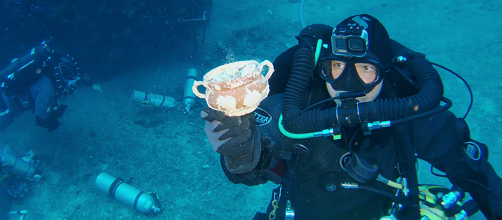Excavation of Antikythera Wreck Discovers Ship’s Hull, Led by Swiss and Greek Archaeologists
The 2024 expedition to the Antikythera wreck, carried out from 17 May to 20 June 2024, has led to a breakthrough in the 2021-2025 research program orchestrated by the Swiss School of Archaeology in Greece (ESAG) and supervised by the Ephorate of Underwater Antiquities of the Hellenic Ministry of Culture and Sports. Thanks to exceptionally favorable weather conditions, the team co-directed by professor Lorenz Baumer from University of Geneva (UNIGE) made significant discoveries, including a significant portion of the ship’s hull.
The most remarkable discovery of 2024 is a structural part of the antique ship. It belongs to a portion of the hull with its original fasteners and external protective coating still in excellent condition. It is made up of planks and frames in their original position and still attached, which allows scientists to think that the construction methodology used at the time was the so-called “shell first”. The builders first made the hull with the boards, and then installed the ribs inside. Nowadays, we proceed in reverse.
According to Professor Lorenz Baumer, from the University of Geneva (UNIGE), co-director of the project with Dr. Angeliki G. Simosi, “this structure allows us to better understand the ship’s construction characteristics that had remained elusive until now, but also to determine the precise location and orientation of the wreck.”
For the first time since its discovery by sponge divers in 1900, the systematic scientific approach has shed new light on this iconic site. Excavations in previous years had raised crucial questions about the potential involvement of several ships in this ancient tragedy; on the circumstances of the shipwreck or on the human remains discovered. This year’s research can partly answer these questions.
A second wreck site confirmed
A specific methodology, applied to the entire research area, made it possible to identify and document the visible pottery remains. This search area extends over two distinct sites, separated from each other by 200 meters of distance. The second area is marked by a concentration of pottery similar to that of the first, but this year’s research has confirmed the presence of a second wooden vessel in this area.
Hidden treasures: marbles and ceramics
New continuous excavation trenches have been opened in the two areas. They have yielded a wealth of archaeological material: about 300 objects, including 21 marble fragments, numerous fragments, and other structural elements of the ship’s hull and more than 200 ceramic shards.
The marble fragments discovered suggest the presence of several statues, while analysis of the amphorae revealed an abundance of varied types, including amphorae from Chios and Rhodes. Analyses have also revealed the use of mastic in some amphorae for their waterproofing.
State-of-the-art techniques for fascinating discoveries
Underwater operations were monitored and coordinated in real time using remotely operated vehicles, and 3D digital models of the selected areas were completed. The use of closed-circuit mixed-gas rebreathers has improved the efficiency and safety of dives.

